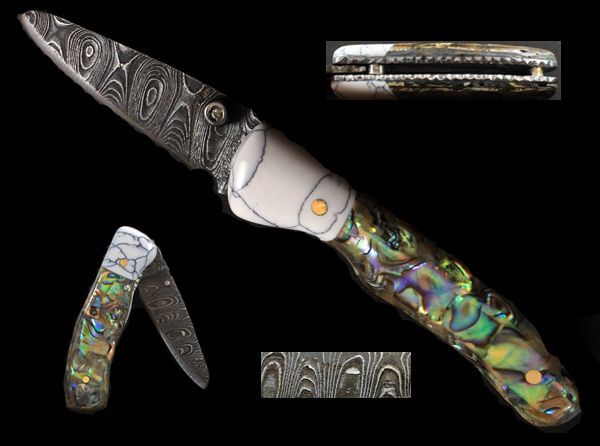| For Sale Now- |
|
Laramie Knifeworks -- Abalone and White Marble Small Buffalo Bill Linerlock
|
| Folder Type: Gentlemen Small Buffalo Bill Linerlock |
| Blade Length: 1 11/16 inches |
| Overall Length: 4 7/16 inches |
| Blade Steel: "Crazy Ladder" Pattern High Carbon Damascus Steel |
| Handle
Material: Abalone Bolster Material: White Marble |
| Thumb Knob Gemstone: A Yellow Sapphire graded IF (which is the highest grade given and means the gemstone is internally flawless and free of inclusions) |
| Filework: On top of blade and liners |
| Liners: Jeweled Small Linerlock |
| Additional
Information:
Abalone is one of the most beautiful
material for making knife handles. The thick inner layer of the
Abalone shell is composed of nacre,
(also present in Mother-of-Pearl), which makes an iridescent shell
with lots and lots of changeable colors as you change the angle of
view. Abalone grown in the wild are expected to go extinct in the
next 200 years because of over harvesting and acidification of
oceans. So now Abalones are farm raised in order to protect the
species. The Abalone I use in my knife handles come from farm raised
Abalone grown in South Korea. The iridescent inner shell of these
farm raised Abalones is often very curved and does not lend itself
for making knives (you need a flat surface instead of a curved
surface for knife handles). But farm raised Abalone can be
commercially processed to form a very nice and beautiful flat
"sheet" by extracting the beautiful inner shell and then
making flat layers which are then glued together to make a usable
thick, strong, flat shell-- which is perfect for making knife
handles. White marble is a popular white stone generally from Italy that is a consistent, light, natural stone with dark gray veining. This piece has been reconstituted by grinding the White Marble into a powder, then adding a binding agent, then dried. This makes slabs of White Marble which can then be used for knife handles. This particular piece has lots of veins and a wonderful sheen and provides a nice contrast to the Abalone shell. |
| Comes With: Pouch and Knife Stand |
| BUY NOW: Click Here |
|
